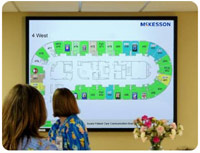McKesson launch whiteboard monitoring system
- 1 May 2008
 |
McKesson has launched its Horizon Enterprise Visibility product – a whiteboard style system that provides real time information of a room’s availability, patient location and the current status of a patient’s treatment – to the UK market.
McKesson say the system is the first visual control system designed specifically for hospitals, and that it enables more time for patient care by all healthcare workers.
Horizon Enterprise Visibility has been used extensively in the US and Germany, with studies identifying a saving of one hour per nurse per shift per day through a reduction of phone calls and wasted logins to various information systems. There was also a reduction in capacity problems by speeding up the bed turnaround process.
McKesson’s commissioning support consultant, Gary Lane, told E-Health Insider: “The Horizon Enterprise Visibility system gives hospitals complete visual control of their sites broadcasting communications in real-time and enabling nurses and clinicians to know what is happening without having to make calls or check electronic systems.”
Usually visible to nurses at the hospital nurse station, information is displayed on a plasma or LCD screen. Existing departmental systems and location technologies, such as RFID systems, populate the visual displays in real-time through colour-coded, time-stamped icons and signal lights mapped against the floor plan of a hospital.
Charmaine McDonald, UK managing director of McKesson, said: “Hospital staff currently rely on an array of devices such as pagers, texts, radio communications and the telephone to keep abreast of the current hospital environment and ward status.
"Horizon Enterprise Visibility uses visual controls to drive and sustain process improvements, which will ultimately increase patient status visibility for all staff and allow increased focus on the core issue of patient care.”
Using over 75 configurable indicators, trusts can set measures to manage their wards’ activities and quickly identify the status of critical test results, patient locations, discharge times and bed or room availability.
This will enable hospital staff to quickly identify isolation patients, fall risks or any other patient safety concerns and flashing timers can be used to indicate key actions required, as well as see the status of a bed or room.
Launched at this week’s Royal College of Nursing Congress in Bournemouth, McKesson say the system has generated a lot of interest and plans are now underway to begin implementation timescales for UK pilot sites.
Lane said: “Nurses have been hugely impressed with the workflow management this system can provide and they are keen to implement such units in their hospitals. The benefits such as awareness and visibility have been noticed by them and we look forward to piloting the system in the UK soon.”
Link




